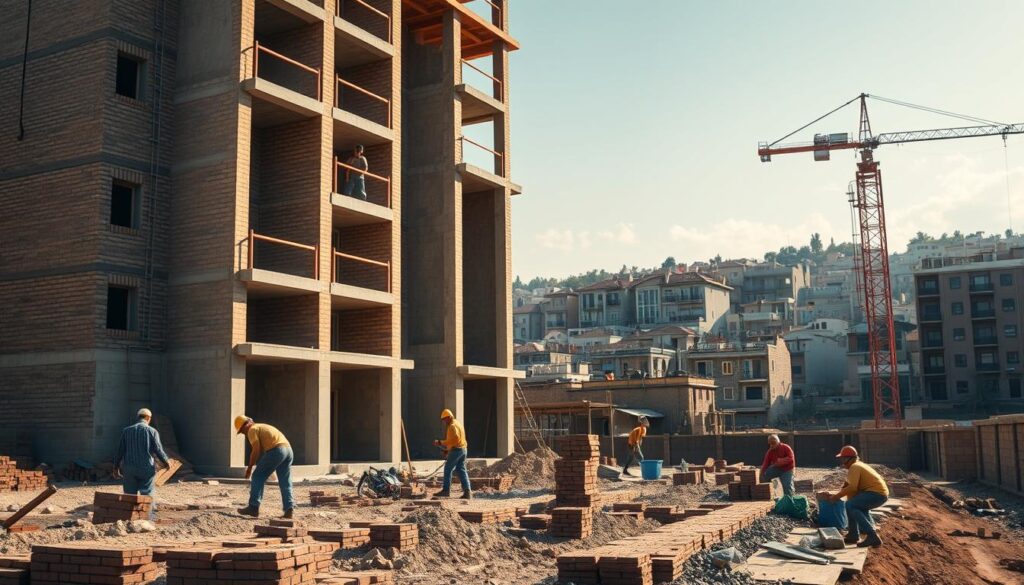Nearly 1.6 billion people worldwide lack adequate housing, a crisis exacerbated by rapid urbanization and economic constraints. Innovative affordable housing construction methods are crucial in addressing this issue.
The need for efficient and cost-effective solutions has led to significant advancements in low cost housing engineering, enabling the development of sustainable and resilient housing.
By leveraging cutting-edge technologies and materials, the construction industry can provide high-quality housing at reduced costs, making homeownership more accessible to a wider population.
Key Takeaways
- Innovative construction methods are key to addressing the global housing shortage.
- Advancements in engineering are making housing more affordable and sustainable.
- Technological integration is crucial for cost-effective housing solutions.
- Sustainable materials play a significant role in affordable housing.
- Efficient construction practices can reduce housing costs significantly.
Understanding Low-Cost Housing Engineering
As the demand for affordable housing continues to grow, understanding low-cost housing engineering is essential. This field involves the application of innovative techniques and materials to reduce construction costs while maintaining the quality and durability of the housing.
Definition and Importance
Low-cost housing engineering refers to the use of cost-effective housing solutions that make housing affordable without compromising on its integrity. It is defined by its focus on budget-friendly housing design and the use of locally available materials. The importance of low-cost housing engineering lies in its ability to address housing shortages, particularly in low-income communities.
By adopting cost-effective measures, low-cost housing engineering helps in making housing more accessible. For more insights on reducing construction costs, visit this guide on cutting construction costs.
Key Principles of Low-Cost Housing
The key principles of low-cost housing engineering include the use of locally sourced materials, efficient design techniques, and innovative construction methods. These principles are crucial in achieving cost-effective housing solutions that are sustainable and durable.
Some of the key strategies involve optimizing building designs for minimal material usage, using locally sourced materials to reduce transportation costs, and applying advanced construction techniques to enhance efficiency.
By understanding and applying these principles, it’s possible to create housing that is not only affordable but also meets the needs of the community. Effective low-cost housing engineering requires a comprehensive approach that balances cost, quality, and sustainability.
Benefits of Low-Cost Housing Solutions
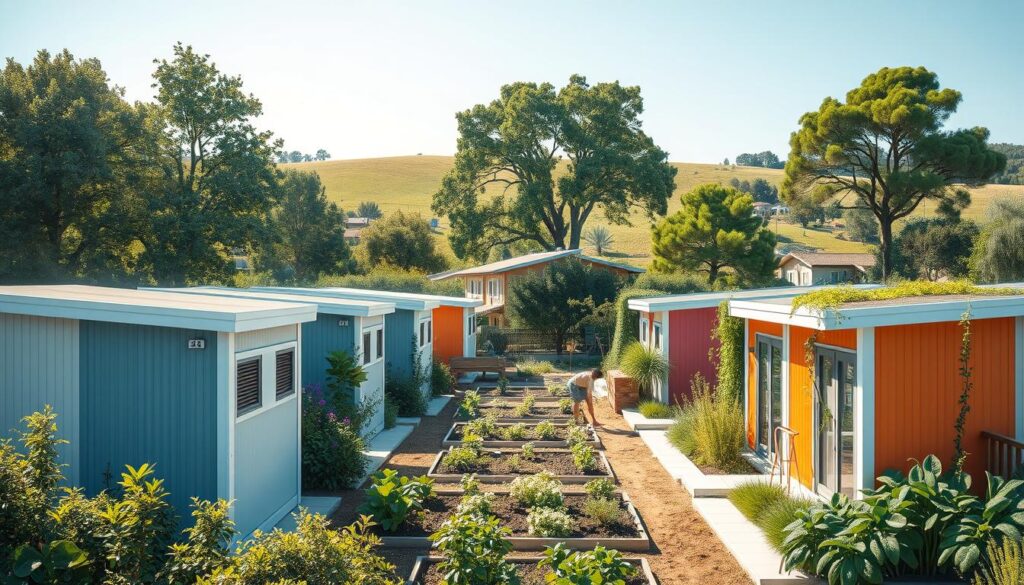
Low-cost housing solutions offer numerous benefits that can transform communities. By providing affordable engineering solutions, these initiatives not only make housing more accessible but also contribute to the overall well-being of residents.
Economic Advantages
One of the primary benefits of low-cost housing is its economic advantages. Reduced construction costs without compromising on quality can significantly lower the financial barrier to homeownership. This is achieved through innovative sustainable low-cost housing techniques that minimize waste and optimize resource use.
Furthermore, low-cost housing projects can stimulate local economies by creating jobs and increasing demand for local materials and services. This economic boost can have a ripple effect, benefiting the community as a whole.
Social Impact
Beyond the economic benefits, low-cost housing solutions have a profound social impact. By making housing more affordable, these initiatives can help reduce homelessness and housing insecurity, leading to more stable communities.
Additionally, affordable engineering solutions in housing can improve the quality of life for residents. For example, well-designed low-cost housing can include community spaces and amenities that foster a sense of community and support social connections among residents.
In conclusion, the benefits of low-cost housing solutions are multifaceted, encompassing both economic advantages and significant social impact. As communities continue to adopt sustainable low-cost housing practices, the potential for positive change is substantial.
Materials Used in Low-Cost Housing
In the pursuit of affordable housing, the choice of construction materials plays a pivotal role. The use of sustainable and locally sourced materials is a key aspect of low-cost housing, as it not only reduces costs but also minimizes environmental impact.
Sustainable Materials
Sustainable materials are crucial in low-cost housing development. Materials like concrete and steel are widely used due to their durability and availability. According to a report, the use of sustainable materials can reduce construction costs by up to 20%. Recycled materials are also gaining popularity for their environmental benefits and cost-effectiveness.
“The use of sustainable materials in construction is not just a trend; it’s a necessity for the future of our planet.” –
The benefits of sustainable materials extend beyond cost savings. They also contribute to a reduction in the carbon footprint of the construction process. For instance, using locally sourced wood can significantly reduce transportation costs and support local economies.
Locally Sourced Options
Locally sourced materials are another vital component of economic housing design. By sourcing materials locally, construction projects can reduce transportation costs and support local businesses. This approach not only boosts the local economy but also ensures that the materials used are well-suited to the local climate and building codes.
- Reduced transportation costs
- Support for local economies
- Better adaptation to local climate conditions
In conclusion, the selection of materials for low-cost housing is a critical decision that affects both the cost and sustainability of the project. By opting for sustainable and locally sourced materials, developers can create affordable housing that is not only economically viable but also environmentally friendly.
Innovative Building Techniques
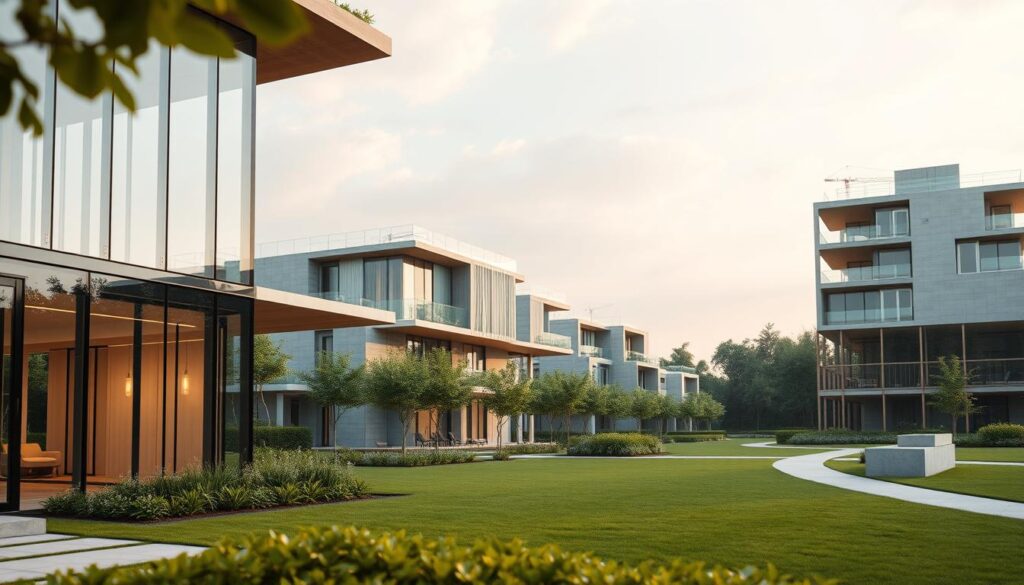
Innovative building techniques are revolutionizing the way we approach low-cost housing engineering. By leveraging advancements in construction technology, the housing industry is becoming more efficient and cost-effective.
Two significant innovations in this area are modular construction and prefabricated components. These methods not only reduce construction time but also minimize waste and lower costs, making housing more affordable for a wider population.
Modular Construction
Modular construction involves building housing units in a factory and then assembling them on-site. This technique offers several advantages, including reduced construction time, improved quality control, and minimized environmental impact.
Benefits of Modular Construction:
- Faster construction times
- Improved quality control
- Reduced on-site waste
- Enhanced safety
Prefabricated Components
Prefabricated components refer to building elements, such as walls, roofs, and floors, that are manufactured in a factory and then assembled on-site. This approach allows for greater precision and reduces the need for skilled labor on-site.
Advantages of Prefabricated Components:
- Increased precision
- Reduced labor costs
- Faster assembly times
- Improved sustainability
| Technique | Construction Time | Cost Savings | Environmental Impact |
|---|---|---|---|
| Modular Construction | Reduced by 30% | Up to 20% | Minimized waste |
| Prefabricated Components | Reduced by 25% | Up to 15% | Reduced on-site labor |
By adopting innovative building techniques such as modular construction and prefabricated components, the housing industry can provide cost-effective housing solutions that are both efficient and sustainable.
Designing for Low-Cost Housing
In the realm of low-cost housing, design plays a pivotal role in determining the quality of life for residents. Effective design can make a significant difference in creating spaces that are not only affordable but also comfortable and sustainable.
User-Centered Design
User-centered design is a crucial aspect of low-cost housing. It involves understanding the needs and preferences of the residents to create spaces that are functional and livable. This approach ensures that the housing is tailored to the users, enhancing their overall living experience.
By incorporating user feedback and preferences, architects and designers can create housing solutions that are both budget-friendly and meet the needs of the community. This might include designing communal spaces that foster a sense of community or incorporating features that improve energy efficiency.
Space Efficiency
Space efficiency is another vital element in the design of low-cost housing. Maximizing the use of available space can significantly reduce construction costs without compromising on comfort. This can be achieved through clever design solutions such as multi-functional rooms and optimized layouts.
Efficient use of space not only reduces costs but also enhances the livability of the housing. For instance, using modular furniture can help in creating flexible living areas that can be adapted according to the needs of the residents.
By focusing on user-centered design and space efficiency, it’s possible to create low-cost housing that is both sustainable and comfortable. This approach not only benefits the residents but also contributes to the overall well-being of the community.
Government Support and Policies
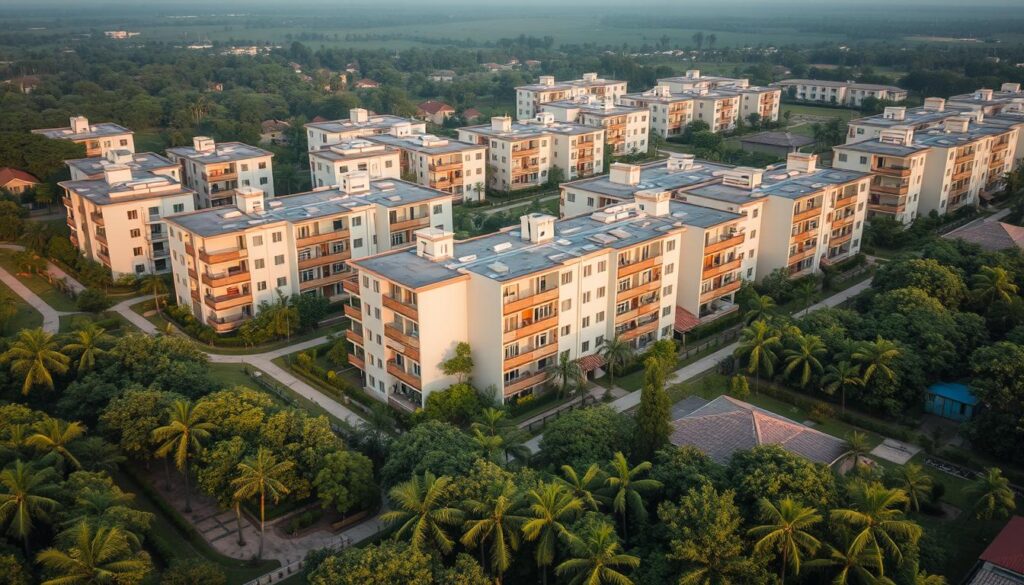
Government policies and support mechanisms are essential for fostering an environment conducive to low-cost housing engineering. These initiatives not only facilitate the development of affordable housing but also ensure that such projects are sustainable and beneficial to the community.
The role of government in low-cost housing is multifaceted, involving financial support, regulatory adjustments, and the implementation of policies that encourage the development of affordable housing. Grants and funding are critical components of this support, enabling developers to undertake projects that might otherwise be financially unfeasible.
Grants and Funding
Government grants and funding programs are designed to support the development of low-cost housing by covering some of the costs associated with land acquisition, construction, and infrastructure development. These financial incentives can significantly reduce the burden on developers, making it more viable to construct affordable housing units.
- Grants for land acquisition and site preparation
- Funding for construction and infrastructure development
- Subsidies for low-income households
By providing such financial support, governments can stimulate the development of low-cost housing, helping to address housing shortages and affordability issues.
Zoning Regulations
Zoning regulations play a crucial role in determining the feasibility of low-cost housing projects. By adjusting zoning laws, governments can encourage the development of affordable housing in suitable areas, ensuring that such projects are integrated into the community.
| Zoning Regulation | Impact on Low-Cost Housing |
|---|---|
| Inclusionary Zoning | Requires developers to include a certain percentage of affordable housing units in new constructions. |
| Density Bonuses | Allows developers to build more units than typically allowed in exchange for including affordable housing. |
| Reduced Parking Requirements | Can lower construction costs by reducing the need for parking infrastructure. |
Effective government support and policies are crucial for the success of low-cost housing engineering projects. By understanding and leveraging these initiatives, developers and communities can work together to create more affordable housing options.
Case Studies of Successful Projects
Successful low-cost housing projects are a testament to the potential of affordable engineering solutions in addressing housing needs. These projects not only provide shelter but also contribute to the well-being of communities by incorporating innovative and sustainable practices.
Examples from Across the U.S.
Several low-cost housing projects across the United States have made significant impacts. For instance, a project in California utilized modular construction to reduce building time and costs, while a development in New York incorporated locally sourced materials to minimize environmental impact.
These examples demonstrate the diversity of approaches to low-income housing development. By leveraging innovative engineering, these projects have managed to stay within budget while enhancing the quality of life for residents.
Lessons Learned
The success of these projects offers valuable lessons for future developments. One key takeaway is the importance of integrating affordable engineering solutions from the outset. This includes using cost-effective materials and construction methods that do not compromise on quality.
“The future of housing lies in our ability to innovate and adapt, making housing more accessible and sustainable for all.” – Housing Expert
Another crucial lesson is the benefit of community involvement in low-cost housing projects. Engaging with local residents and incorporating their feedback can lead to more successful and sustainable outcomes.
By examining these case studies and the lessons they provide, developers and policymakers can better navigate the challenges of low-income housing development, ultimately creating more affordable and sustainable housing solutions.
Role of Technology in Housing Engineering
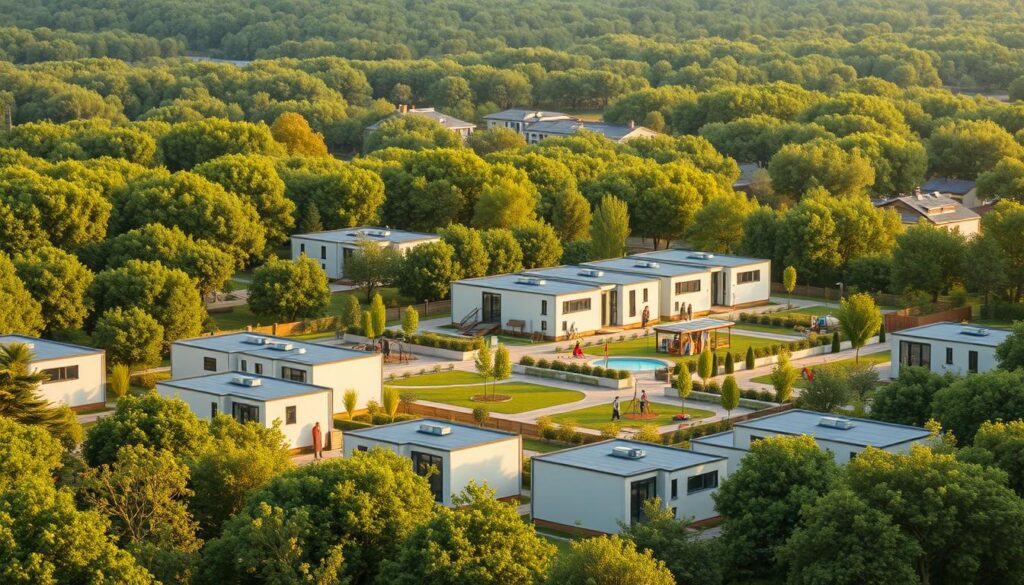
The integration of technology in housing engineering has revolutionized the construction process, making it more efficient and cost-effective. By leveraging advanced technologies, the housing sector can now achieve higher quality and sustainability standards.
Smart Building Solutions
Smart building solutions are transforming the way housing is constructed and managed. These solutions incorporate advanced technologies such as IoT sensors, energy management systems, and automated building controls to enhance the living experience. For instance, smart home systems can optimize energy consumption, reducing utility bills and environmental impact.
“The future of housing is not just about building homes, it’s about creating intelligent living spaces that adapt to the needs of the inhabitants.”
Some of the key benefits of smart building solutions include:
- Enhanced energy efficiency
- Improved security and safety
- Increased comfort and convenience
- Better maintenance and management
Construction Management Tools
Construction management tools are crucial for the successful execution of housing projects. These tools enable project managers to plan, coordinate, and monitor the construction process more effectively. Technologies such as Building Information Modeling (BIM) and project management software help in streamlining workflows, reducing delays, and improving collaboration among stakeholders.
| Tool | Description | Benefits |
|---|---|---|
| BIM | Building Information Modeling | Enhanced project visualization, improved collaboration |
| Project Management Software | Software for managing construction projects | Streamlined workflows, reduced delays |
By adopting these technologies, construction companies can achieve significant improvements in productivity and cost savings. For example, a study by McGraw-Hill Construction found that the use of BIM can reduce project costs by up to 20%.
In conclusion, technology plays a vital role in housing engineering, offering numerous benefits in terms of cost-effectiveness and sustainability. By embracing smart building solutions and construction management tools, the housing sector can continue to evolve and meet the demands of a growing population.
Community Involvement in Housing Development
By engaging local residents, housing development projects can better meet the needs of the community. Community involvement is crucial for creating affordable urban development initiatives that are both sustainable and effective.
Engaging Local Residents
Engaging local residents in the planning and development process ensures that housing projects are tailored to the community’s needs. This can be achieved through public meetings, surveys, and collaborative design processes. For instance, residents can provide valuable insights into the required amenities and design preferences, leading to more successful projects.
Benefits of Community-Built Housing
Community-built housing not only fosters a sense of ownership among residents but also contributes to the development of budget-friendly housing design. By involving the community in the construction process, projects can reduce labor costs and improve the overall quality of the housing. For more information on innovative approaches to affordable housing, you can refer to research papers such as the one on Engineering-Based Methods for Affordable Housing.
The benefits of community involvement in housing development are multifaceted, leading to more sustainable and effective housing solutions. By prioritizing community engagement, developers can create housing projects that truly meet the needs of local residents.
Environmental Considerations

As the world shifts towards more sustainable practices, environmental considerations in low-cost housing have become increasingly crucial. The integration of green building practices and energy efficiency is pivotal in reducing the ecological footprint of housing projects.
Green Building Practices
Green building practices involve the use of sustainable materials, minimizing waste, and optimizing energy use. Emerging green building innovations are transforming the construction industry, enabling the development of eco-friendly low-cost housing. Some key strategies include:
- Using locally sourced materials to reduce transportation emissions
- Implementing recycling programs for construction waste
- Incorporating green roofs and walls for insulation and biodiversity
These practices not only contribute to environmental sustainability but also enhance the quality of life for residents by creating healthier living environments.
Energy Efficiency
Energy efficiency is a critical component of sustainable low-cost housing. By designing homes that consume less energy, we can reduce utility costs for residents and minimize the overall environmental impact. Strategies for achieving energy efficiency include:
- Installing energy-efficient appliances and lighting
- Enhancing insulation to reduce heating and cooling needs
- Utilizing renewable energy sources such as solar and wind power
The adoption of energy-efficient designs and technologies is vital for creating sustainable low-cost housing that is both economically viable and environmentally friendly. For more information on the housing crisis and the need for sustainable solutions, visit https://sustainable-earth.org/housing-crisis/.
By focusing on green building practices and energy efficiency, we can develop housing solutions that are not only affordable but also sustainable for the long term.
Challenges in Low-Cost Housing Engineering
Despite its benefits, low-cost housing engineering is fraught with challenges, including financial and construction-related issues. The development of affordable housing requires overcoming these hurdles to make low-cost housing viable and sustainable.
Financial Constraints
One of the primary challenges in low-cost housing engineering is financial constraints. Securing funding for affordable housing projects can be difficult due to limited government grants and private investment. Efficient budget management is crucial to ensure that projects stay within financial limits. This involves careful planning and cost-effective strategies to minimize expenses without compromising the quality of housing.
To address financial constraints, innovative financing options and public-private partnerships can be explored. These approaches can help in leveraging resources and expertise to support affordable housing initiatives. Additionally, government support and policies play a vital role in providing the necessary financial backing and incentives for low-cost housing projects.
Construction Barriers
Construction barriers pose another significant challenge in low-cost housing engineering. These barriers can include regulatory hurdles, supply chain issues, and logistical challenges. Streamlining regulatory processes and adopting modular construction techniques can help mitigate some of these barriers. Modular construction, for instance, can reduce on-site labor costs and construction time, making it a viable option for affordable housing.
Furthermore, addressing construction barriers requires a collaborative effort among stakeholders, including builders, policymakers, and local communities. By working together, it’s possible to identify and implement effective solutions that overcome construction-related challenges and facilitate the development of low-cost housing.
Future Trends in Affordable Housing
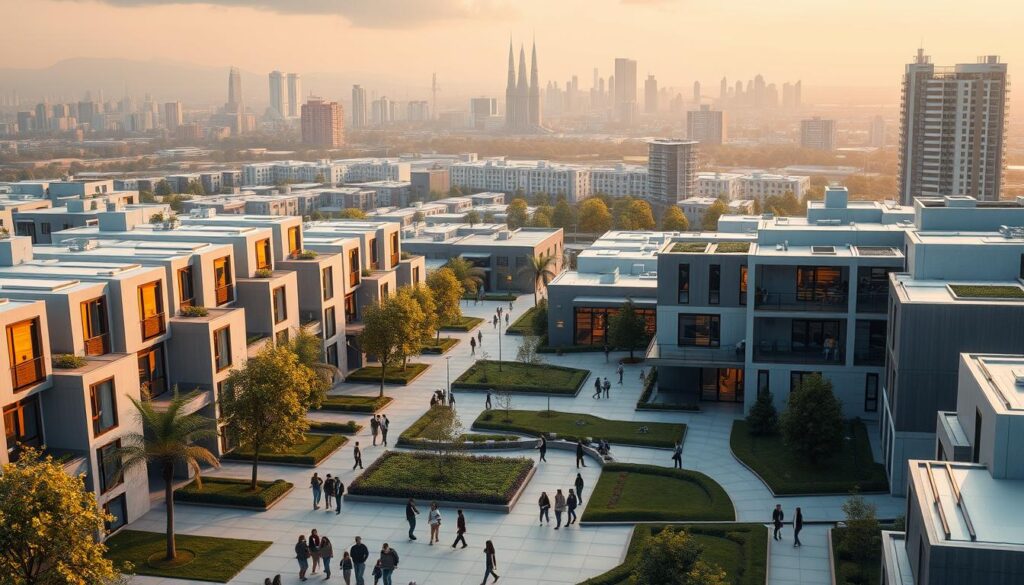
The future of affordable housing is being shaped by sustainable urban development, which focuses on creating environmentally friendly and economically viable housing solutions. As cities continue to grow, the need for affordable housing that aligns with sustainable practices becomes increasingly important.
Sustainable Urban Development
Sustainable urban development involves designing cities and housing projects that minimize environmental impact while promoting economic growth and social equity. This approach includes using green building materials, optimizing energy efficiency, and incorporating renewable energy sources. For instance, a study on innovative affordable housing solutions highlights the potential of sustainable urban development in creating cost-effective housing.
- Implementing green infrastructure to reduce urban heat islands
- Promoting mixed-use development to reduce commute times
- Incorporating public transportation to enhance accessibility
Innovative Financing Options
Innovative financing options are crucial for making affordable housing a reality. This includes exploring new funding models, such as public-private partnerships and community land trusts, which can help reduce costs and increase accessibility. By leveraging these financing options, developers can create more affordable housing units without compromising on quality.
| Financing Option | Description | Benefits |
|---|---|---|
| Public-Private Partnerships | Collaboration between government and private entities to fund housing projects | Increased funding, shared risk |
| Community Land Trusts | Non-profit organizations that hold land for the benefit of the community | Affordable housing, community control |
As the affordable housing landscape continues to evolve, embracing cost-effective housing solutions and sustainable practices will be key to addressing the housing needs of future generations.
How to Get Involved in Low-Cost Housing Projects
Community involvement is crucial in making housing more affordable. Individuals can play a significant role in supporting low-cost housing initiatives through various means.
One way to get involved is by exploring affordable housing development programs, such as the Howard and Irene Levine Affordable Housing Development Program, which offers comprehensive training on budget-friendly housing design and low-income housing development.
Volunteering and Local Initiatives
Volunteering opportunities exist in organizations focused on building affordable homes. Supporting local initiatives that promote sustainable and community-driven housing projects is another effective way to contribute.
By engaging in these activities, individuals can help address the housing crisis and promote more equitable and affordable living conditions. Whether through volunteering or supporting local initiatives, every effort counts in making a difference in the lives of those in need of budget-friendly housing.
